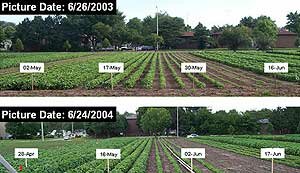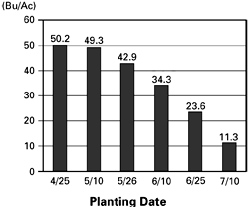
-
Soybean Diseases
- Asian Rust
- Anthracnose
- Bacterial Blight
- Bacterial Pustule
- Bean Pod Mottle Virus
- Brown Stem Rot
- Cercospora Leaf Blight
- Charcoal Rot
- Downy Mildew
- Frogeye Leaf Spot
- Green Stem Syndrome
- Iron Deficiency Chlorosis
- Phytophthora Root & Stem Rot
- Powdery Mildew
- Rhizoctonia
- Seedling Diseases
- Septoria (Brown Spot)
- SCN (Soybean Cyst Nematode)
- Soybean Mosaic Virus
- Stem Canker
- Sudden Death Syndrome
- Viruses
- White Mold
- Pests
- BioControl
- Diagnostic Tools
- About PHI
- Soybean Library
| Cropping Systems |
Your Soybean Checkoff.
Delivering Results.
University of Illinois
Southern Illinois University
Iowa State University
Kansas State University
Michigan State University
University of Minnesota
University of Missouri
University of Nebraska
North Dakota State University
Ohio State University
Purdue University
South Dakota State University
University of Wisconsin
Soybean Planting Date

|
| The earlier the soybean planting, the earlier the canopy closes. These pictures were taken just a few days after the longest day of the year. Once the canopy closes, the crop is collecting all the available sunlight. Click on image to view a larger version. Photo credit: James Specht, University of Nebraska. |
Adjusting soybean planting date is one of the most important and least expensive cultural practices you can do to increase yield. If growing conditions are favorable, planting early offers an opportunity to capture the maximum yield potential of a soybean variety.
Early-planted soybeans use a larger portion of the summer’s total sun and heat, and planting early provides an opportunity to plant a longer-season variety.
Planting soybean early is recommended only when seedbed conditions are good. Planting in wet soils just to plant early – causing soil compaction and poor seed placement – will outweigh any benefit of early planting.
Yield advantage of early planting
Research conducted throughout the Midwest consistently shows a yield advantage to planting early provided that planting conditions are good.
In Nebraska, crop physiologist James Specht reported that soybean yield declined from one-quarter bu/acre to about 5/8 bu/acre for each day planting was delayed after May 1 (Nebraska Crop Watch 2008).
Similar results were found at the University of Wisconsin, Arlington Research Station, where an average yield loss of 0.4 bu per acre per day occurred when soybean planting was delayed past the first week in May (Wisconsin Crop Manager 2008).
Based on 24 experiments across Iowa since 2003, ISU agronomists reported a 79 percent probability of achieving a higher yield by planting the last week of April (southern two thirds of Iowa) or the first week of May (northern one third of Iowa) compared with approximately May 20. In this research, the largest response to planting date was usually found in fields with high yield potential. In situations with lower yield potential, mainly because of poorly drained fields, high levels of soybean cyst nematode, or sudden death syndrome, the yield response to planting date was much lower.
 |
| Figure 1. The results of numerous research studies conducted in Ohio since 1970 have demonstrated that the date of planting has more effect on soybean grain yield than any almost any other production practice. |
The results of numerous research studies conducted in Ohio since 1970 (Figure 1) have shown that the yield loss resulting from delayed planting ranges from one-fourth bushel to more than one bushel per acre per day. Current recommendations for southern Ohio is to plant soybeans any time after April 15 when soil conditions are suitable. In northern Ohio, planting should begin the last few days of April, if soil conditions are satisfactory.
Canopy closure is the goal
The soybean crop should develop a closed canopy by the end of June or early July. This can be achieved by adjusting both the planting date and the row width. In Ohio, for example, when planting in early May, rows must be less than 15 inches apart to form a canopy by late June.
An early canopy results in high yields because more sunlight is intercepted in early stages of growth and the canopy is complete by the critical, yield-determining growth stage of pod set (R3).
Evaluate seedbed conditions
Planting in wet soil just to plant early – causing soil compaction and poor seed placement – will outweigh any benefit of early planting. Soil crusting from excessive tillage or a hard rain just after planting can also reduce stand establishment and negate the benefits of early planting.
However, it is not necessary to wait until soil temperatures are high. Although the ideal soil temperature for rapid soybean germination and emergence is between 77 to 86ºF, soybean will begin to germinate at soil temperatures around 50ºF. Germination will be slow, and planting depth should be 1 to 1.5 inches.
| Benefits of planting early | Risks of planting early |
|
|
Potential risks of injury or disease when planting early
Adequate, vigorous stands are sometimes more difficult to obtain with early planting. Seed treatments, good seed-soil contact, and reduced seeding depths can all help to establish the stand. Herbicide programs must provide weed control for a longer time until the crop is large enough to suppress weed growth through competition.
The cool, wet weather of early spring can favor some early-season diseases of soybean. Poorly-drained and compacted soils slow root growth and increase the potential of injury due to seedling diseases. Pythium root rot is the most common seedling disease in the Midwest, followed by Rhizoctonia and Phytophthora. A fungicide seed treatment may be needed to protect the seed during stand establishment. Early-planted soybeans may be at higher risk for infection by Fusarium virguliforme, the pathogen that causes sudden death syndrome (SDS). This fungus prefers cool soil for infection. The best preventative is to plant an SDS-resistant soybean variety.
Soybean seedlings may be damaged if air temperatures drop below 27-28°F. Sometimes only the upper leaves are damaged and not the growing points, and growth will resume from the surviving buds.
Early-planted soybeans should be scouted regularly for bean leaf beetles. The beetles overwinter under leaf debris near soybean fields and are active in the early spring. They feed on wild legumes, alfalfa and clovers, but will quickly abandon these hosts as soon as soybeans emerge.
The growth and pathogenic activity of the white mold fungus is favored by dense soybean canopies created by early planting, planting in narrow row widths, high seeding densities, high soil fertility and other factors that maximize yield. This situation is unfortunate because white mold penalizes the progressive soybean grower.
Resources
Three Reasons Why Soybean Planting Date Matters - University of Nebraska
Soybean Production - Ohio State University
